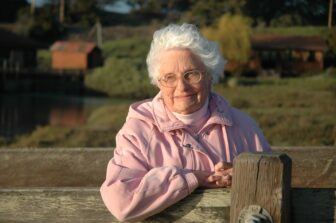Florence’s love of the outdoors can be traced all the way back to her childhood years, growing up in the suburbs 20 minutes east from downtown Los Angeles. Back in the mid-1920s, the area was just beginning to transform into the huge metropolitan city we think of today.
Out on the edges of town there were still wild areas – places Florence and her two brothers, Harry and John, spent their childhoods exploring. “We lived in a wonderful place,” she remembered. “There was this wild area across the street from us with a creek, a pond, trees, and barren hills for a long way.”
In 1941, Florence and her parents moved north to the Bay Area, following her two brothers. Both were studying at UC Berkeley and Florence enrolled in the fall of that year. It was at UC Berkeley that Florence met her future husband Philip while taking a German language class. She would transfer after two years, and received a B.S. in nursing from San Francisco State
University.
After graduation from college, and after the war (Philip served in the Air Force stationed at Seething Air Base in England), the pair moved to Palo Alto. And that move was the spark that ignited Florence’s passion for protecting the habitats of the Bay and in particular tidal wetlands. Distraught by the destruction of tidal wetlands her young family enjoyed visiting on hot summer evenings, Florence responded to a small ad in a local newspaper, by Santa Clara County planner Arthur Ogilvie, that read, “If you’re worried about what’s happening to the shore of the San Francisco Bay, come to my office in the morning at 10 o’clock.” Mr. Ogilvie’s inspired goal was to seek congressional authorization to establish a national wildlife refuge in South San Francisco Bay.
Despite having a full-time job and a young family, Florence eagerly poured her remaining time into the effort to establish what would become one the nation’s first and largest national wildlife refuge in an urban setting. She and others worked tirelessly alongside Art Ogilvie, and Refuge champion Congressman Don Edwards. It took four long years, but eventually, in 1972, legislation was passed authorizing what is now known as the Don Edwards San Francisco Bay National Wildlife Refuge.
In 1985, realizing that the original Refuge authorization covered mostly salt pond habitat, and that many other important baylands habitats were not protected from development, Florence and the Citizens Committee to Complete the Refuge went back to Congressman Don Edwards seeking to expand the acreage of the original Refuge footprint to include these other habitat types. The congressional authorization to expand the Refuge was enacted in 1988, the first year it was submitted to Congress.
Florence has mentored generations of wetlands advocates – environmental activists from as far away as Venezuela and Japan have reached out to her, forming connections and friendships based on mutual admiration. She continues to fight to protect undeveloped lands identified as potential additions to the Refuge, and to protect wetlands and listed species. On occasion, reflecting on all that she has accomplished, people will sometimes ask if she hasn’t done enough, if she isn’t ready to stop her advocacy for the Bay. In a response so typically Florence she says, “People tell me that I should be satisfied. But how could anyone be satisfied with what’s happened when a beautiful site like Newark Area 4 is out there unprotected?”
When asked if she had any advice for new activists, Florence replied, “You have to be patient and do a lot of homework. You’ll have a lot of defeats, but the victories are glorious too.” She added, “Look at what we have on the edges of the Bay. Each place is a tribute to all the people who have put their hearts and souls into keeping those lands as they once were.”
